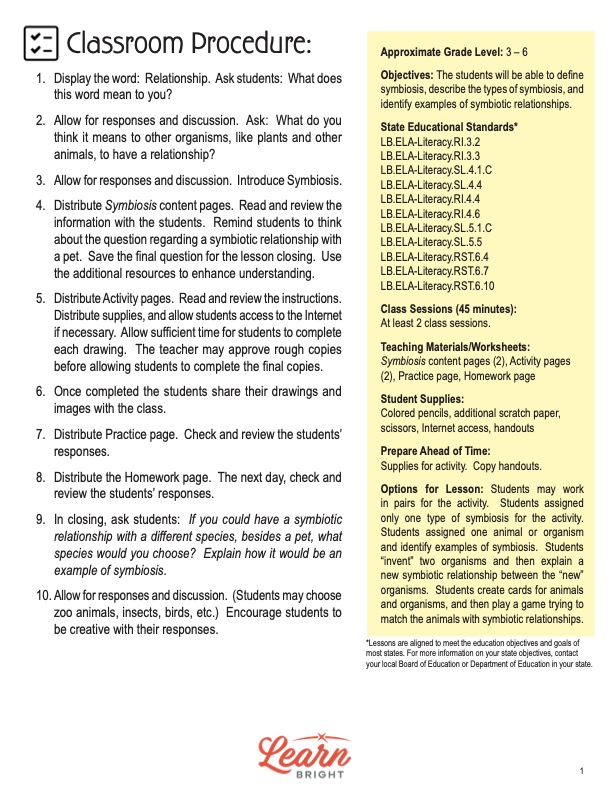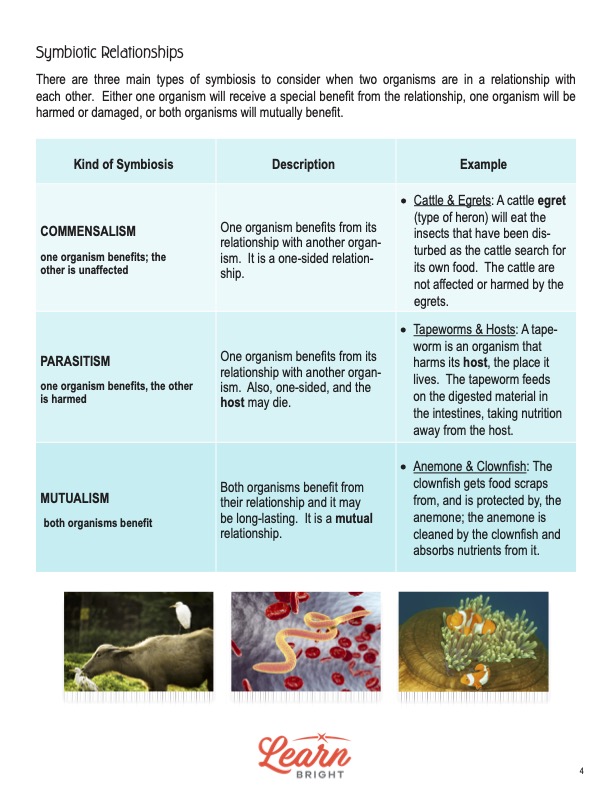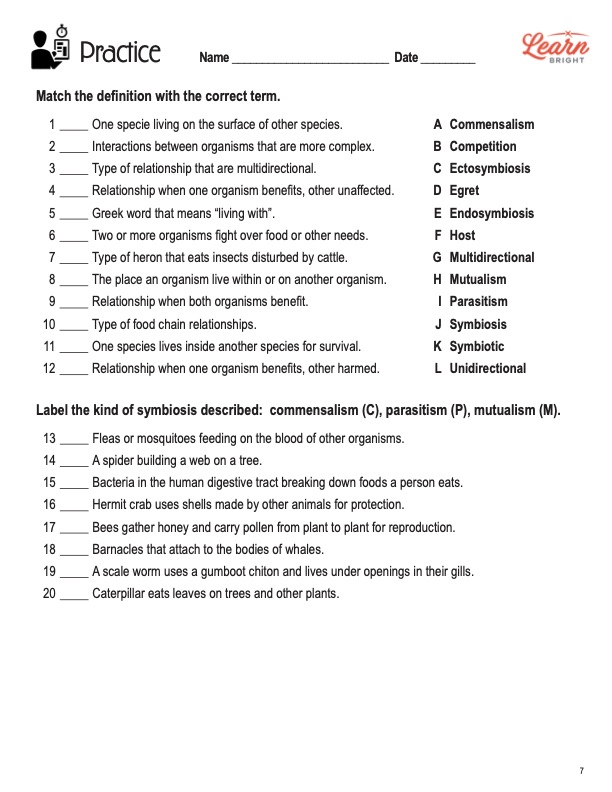Description
What our Symbiosis lesson plan includes
Lesson Objectives and Overview: Symbiosis teaches students about three types of relationships that certain animals have with each other. At the end of the lesson, students will be able to define and explain what each type of symbiotic relationship entails. They will also be able to provide examples of animal relationships that fall into each category. The lesson is for students in 3rd grade, 4th grade, 5th grade, and 6th grade.
Classroom Procedure
Every lesson plan provides you with a classroom procedure page that outlines a step-by-step guide to follow. You do not have to follow the guide exactly. The guide helps you organize the lesson and details when to hand out worksheets. It also lists information in the yellow box that you might find useful. You will find the lesson objectives, state standards, and number of class sessions the lesson should take to complete in this area. In addition, it describes the supplies you will need as well as what and how you need to prepare beforehand.
Options for Lesson
In the “Options for Lesson” section of the classroom procedure page, you will see several suggestions for additional activities or alternatives for the lesson. One option is to assign students only one type of symbiosis to represent for the activity instead of all three types. You could also assign students one animal or organism and have them identify examples of symbiosis for that animal. Another option is for students to “invent” two organisms and create a new symbiotic relationship between them. A final idea is to have students create cards for animals and organisms and then play a game trying to match the animals with their symbiotic relationships.
Teacher Notes
The paragraph on the teacher notes page provides a little extra guidance and information about the lesson. It notes that students are generally excited to learn about animals, so it could be fun to teach this lesson in conjunction with other lessons that also relate to animals. Use the blank lines to write down any other ideas or thoughts you have for the lesson.
SYMBIOSIS LESSON PLAN CONTENT PAGES
What Is Symbiosis?
The Symbiosis lesson plan includes three pages of content. It introduces this concept by explaining that there are many types of human relationships, such as parent to child, brother to sister, or teacher to student. There are also relationships between other living organisms, like plants and animals. The food chain among living organisms involves unidirectional relationships, meaning that they simply go in one direction. People eat plants, but plants don’t eat people.
However, there are also multidirectional relationships that are more complex. Students will discover that these are called symbiotic relationships. The word symbiosis comes from two Greek words that mean “living with.” These relations occur when two unlike organisms from different species become closely associated with each other, and at least one of the organisms benefits from the relationship. The relationships people have with each other are not considered symbiotic because they are of the same species.
The Three Types
This lesson discusses the three main types of symbiotic relationships: commensalism, parasitism, and mutualism. With commensalism, one organism benefits while the other remains unaffected. It is, essentially, a one-sided relationship. An example of commensalism is the relationship between cattle and the cattle egret. An egret is a type of heron that eats insects that have been disturbed as cattle search for food. Nothing happens to the cattle, but the egrets get food.
Parasitism occurs when one organism benefits from a relationship, but the relationship harms the other organism. This makes it a one-sided relationship as well. Tapeworms are an excellent example of this. A tapeworm harms its host because it feeds on the digested material in the host’s intestines, which takes nutrition from the host.
With mutualism, both organisms benefit from the relationship, not just one. These can even be long-lasting relationships. For instance, clown fish and anemones share a mutualism symbiotic relationship. The clownfish receives food scraps from the anemone and in return cleans the anemone. In addition, the anemone protects the clownfish and absorbs nutrients from it.
Other Relationships
The last page describes the difference between endosymbiosis and ectosymbiosis. Endosymbiosis involves a relationship in which one species lives inside another species, such as protozoans that live inside termites and help them digest wood. Ectosymbiosis involves a relationship in which one species lives on the surface of another species. An example of this is lice that feed on the skin, blood, or oil secretions of its host. With these types of symbiosis, the organisms partner together and live like a single organism. A final type of symbiosis involves competition, in which both members of the association fight over food or other needs. Examples include different species fighting over the best food or nesting area.
The beginning of the lesson asks students to think about whether or not a human and their pet, such as a dog, represent a symbiotic relationship. At this point, they may realize that the answer is yes! Humans provide food, shelter, and love to the animal. The animal provides companionship, protection, and comfort to the human. It represents an instance of mutualism.
Key Terms
Here is a list of the vocabulary words students will learn in this lesson plan:
- Unidirectional: a relationship that goes one way, such as is the case with the food chain
- Multidirectional: a relationship that is more complex and can go in multiple directions
- Symbiosis: a term meaning “living with” that describes relationships in which one or both organisms benefit from the relationship
- Commensalism: a relationship in which one organism benefits and the other is unaffected
- Parasitism: a relationship in which one organism benefits and the other is harmed
- Mutualism: a relationship in which both organisms benefit
- Host: a term to describe the organism that a parasitic organism attaches to and harms in a parasitic symbiotic relationship
- Endosymbiosis: a relationship in which one organism lives inside of another
- Ectosymbiosis: a relationship in which one organism lives on the surface of another
- Competition: a relationship in which two organisms of different species fight over something
SYMBIOSIS LESSON PLAN WORKSHEETS
The Symbiosis lesson plan includes three worksheets: an activity, a practice worksheet, and a homework assignment. These worksheets will help students solidify their grasp on the concepts and material they learned throughout the lesson. The guide on the classroom procedure page outlines when to hand out each worksheet to your students.
THREE POSTER ACTIVITY WORKSHEET
For the activity, students will create posters or displays that describe each of the three types of symbiosis. They will draw pictures or use images they find online or in other resources. There are three empty boxes on the worksheet that they can use as rough drafts for their posters. The final drawings should include text that explains the type of symbiosis and other details that will help viewers understand. When all the students finish, they can share their work with the class.
SYMBIOSIS PRACTICE WORKSHEET
The practice worksheet contains two sections. The first section lists 12 definitions. Students will match the definitions to the correct term in the word bank. For the second section, students will read through 8 descriptions that represent different types of symbiosis. They will write whether or not the statement reflects commensalism (C), parasitism (P), or mutualism (M).
TRUE OR FALSE HOMEWORK ASSIGNMENT
Similar to the practice worksheet, there are two sections of the homework assignment. The first section lists 10 statements that students must decide are true (T) or false (F). The second section requires students to respond to four prompts that ask them to explain a how a certain scenario can represent symbiosis.
Worksheet Answer Keys
The last two pages of the lesson plan are the answer keys for the practice and homework worksheets. The answer key for the practice worksheet shows the correct responses in red for both sections. On the homework, the true or false section also has the correct responses in red. However, the second section provides sample answers. Students’ responses will vary from these answers. If you choose to administer the lesson pages to your students via PDF, you will need to save a new file that omits these pages. Otherwise, you can simply print out the applicable pages and keep these as reference for yourself when grading assignments.









